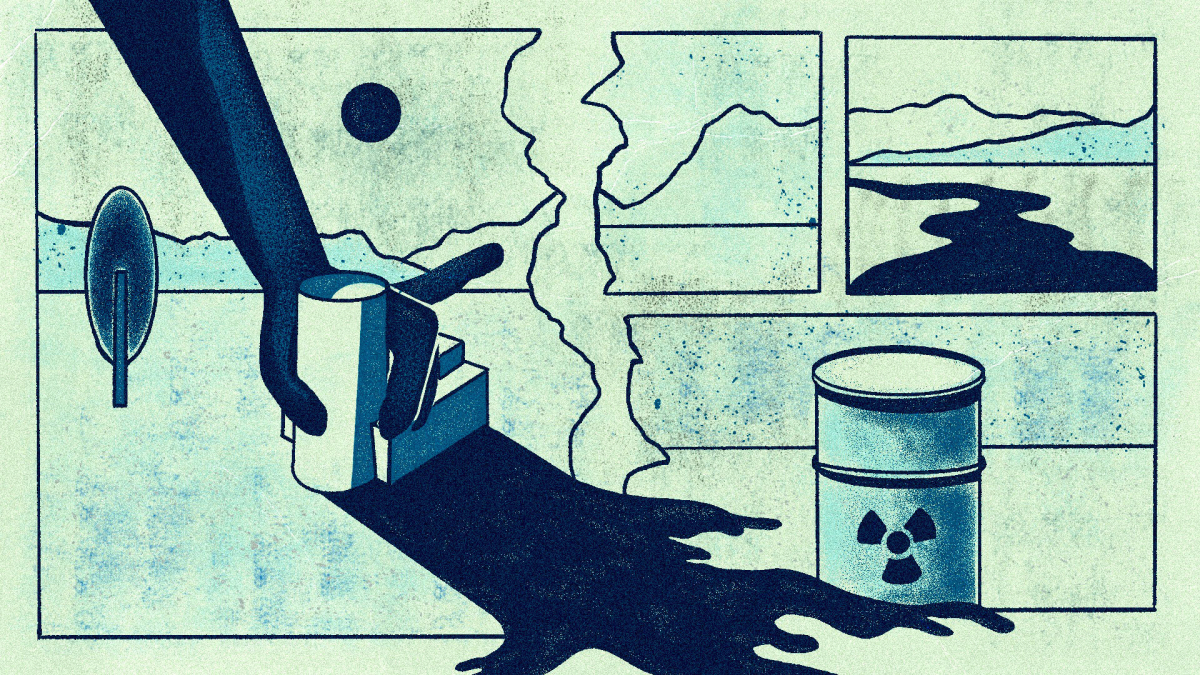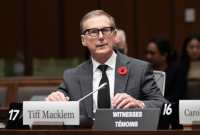Support strong Canadian climate journalism for 2025
Nuclear proliferation experts are warning that 50 years of policy designed to limit the spread of nuclear weapons is unravelling as governments invest in certain small modular reactors that could be misused to build bombs.
The concerns are aimed at Moltex, a Saint John, N.B., nuclear startup building small modular reactors (SMRs) that will be powered with spent fuel from CANDU reactors. To make the fuel, Moltex plans to separate plutonium from uranium in CANDU waste and use the extracted plutonium to power new SMRs.
It is this separation process that led a dozen nuclear scientists to write to Prime Minister Justin Trudeau in September, warning him that Moltex is a nuclear weapon proliferation risk and calling for a formal risk assessment of emerging nuclear technologies.
Edwin Lyman, Union of Concerned Scientists nuclear power safety director, was one of the signatories of the letter. Lyman — who has testified multiple times before the U.S. Congress and the Nuclear Regulatory Commission on the topics of nuclear power safety, security and proliferation — said that by separating and concentrating plutonium, Moltex is completing one of the most difficult steps on the path to making a bomb.
“The very process of extracting plutonium from the spent nuclear fuel and concentrating it is itself a very serious proliferation and security threat because you're simply doing the work of the bad guys for them by concentrating and extracting plutonium,” he said.
Extracting plutonium from nuclear waste, converting it into a fuel and then transporting the fuel to a reactor increase the nuclear weapon proliferation threat “immensely,” Lyman said. The alternative is leaving the plutonium in the waste, where it is more difficult to extract, he said.
Currently, nuclear waste created by existing reactors is stored in facilities designed for interim storage. But because the waste stays radioactive for thousands of years, long-term storage solutions are a pressing concern. Canada is exploring plans to deal with the waste by burying it deep underground. Moltex, which has received at least $50.5 million worth of federal government subsidies, $10 million from New Brunswick, and $1 million from Ontario Power Generation (and is eyeing roughly $200 million more), said its SMRs, which will use plutonium extracted from the waste and use it as new energy to power a reactor, is another viable solution because the waste becomes less radioactive in the process.
Both recycling and burying spent nuclear fuel come with risks. Burying the waste deep underground could hypothetically mean the site could be exploited as a plutonium mine for future nuclear weapon production while reprocessing it could open the door for clandestine repurposing.
The reactor technology is still being developed, but in the view of nuclear weapon proliferation experts interviewed by Canada’s National Observer, the Moltex design is similar enough to previously studied nuclear technologies that are called “proliferation-prone” rather than “proliferation-resistant.” For that reason, the company should be stopped in its tracks, they say.
“If you point out those [security] risks, [nuclear power advocates] say, ‘Oh well, you're just against nuclear power’ but of course, that's not what we're saying,” said Alan Kuperman, associate professor of public affairs at the University of Texas and founding co-ordinator of the Nuclear Proliferation Prevention Project. “The criticism is, this particular type of nuclear application is less safe, or less secure, than others.”
Moltex CEO Rory O’Sullivan told Canada’s National Observer that when dealing with nuclear energy, there will always be risks but in this case, the concern is misplaced and would be adequately responded to through international best practices and regulation. Moreover, he said the Moltex reactor could actually help deal with long-term radioactive waste and, therefore, could be part of a long-term solution.
From O’Sullivan’s perspective, there is already a lot of nuclear waste in the world that could be used to make weapons and so it makes sense to reduce radioactivity and destroy weapons-usable material by putting it through the Moltex reactor. However, he concedes that handling and transferring spent fuel does create a “temporary, short change of risk profile.” Still, he’s adamant Moltex is “not doing the bad guy’s work for them” and that reprocessing spent fuel the way his company intends “is the best proliferation solution because it eliminates the problem in a manageable way.”
“Yes, it would be easier to start from the end of our process and then go and make weapons-grade plutonium [rather] than digging it up out of the ground,” he said. “But that's a very short window because we're processing it with a regulated facility in line with international best practices, in line with a democratic government that has very clear regulations on this, and we will have armed guards because that's what's required for international [best] practice and regulations.”
The fuel “goes straight from our process directly into the reactor facility next door, where it's destroyed,” he added.
And in a crisis situation where terrorists hypothetically overtake the facility, they would only have access to whatever “small stockpile” is physically there, an amount O’Sullivan said “definitely would not be enough to make any sort of meaningful bomb.”
Kuperman said it's “misleading” to say the proliferation risk is only for a short period of time because Moltex not only would need to reprocess spent fuel at the start of its process to obtain the plutonium it needs but would also reprocess the fuel over the life of the reactor to “remove undesired products of reactor operation.” In other words, the proliferation risks last the life of each reactor, which is estimated at 60 years.
He said safeguards are also difficult, if not impossible, to implement when the risk is that plutonium could be diverted from the reactor to make bombs because discovering misuse after the fact is too late. A 2009 study from six U.S. national laboratories analyzing various types of nuclear-reprocessing technologies, some of which Kuperman described as similar to Moltex’s design, emphasized this risk.
“While an attempt by the state to separate pure plutonium in facilities using these technologies might be readily detected, once the state has withdrawn or broken out from its non-proliferation obligations, estimates of the time to convert the facility to separate pure plutonium ranges from a few days to a few weeks,” the study found.
That 2009 study is “objective and authoritative,” Kuperman said. “By contrast, the Moltex CEO is a businessman trying to make money by downplaying the nuclear weapons proliferation risks of his technology.”
In Kuperman’s view, the big picture is that there is a documented history of nuclear energy with peaceful purposes in mind having been misused to create bombs — and there is no reason to risk it again.
In the 1970s, India built nuclear weapons after importing nuclear energy technology from the U.S. and Canada under the pretence of peaceful purposes.
“India used that fuel cycle technology to extract pure plutonium, made it into a bomb, and exploded the bomb in 1974,” Kuperman said. “And that woke up governments around the world.”
At the time, countries like South Korea, Brazil and others were embarking down the nuclear energy path using what has since been called “proliferation-prone” technologies. It stopped when the United States effectively blocked the sales to push other “proliferation-resistant” technologies instead, fearing the geopolitical risk of other countries acquiring nuclear weapons. Kuperman added that proliferation-resistant nuclear technology was also conveniently cheaper, and so the U.S. was able to largely prevent the spread of technologies that could be repurposed for bombs.
“What you have now are folks coming along — in Canada, in the U.S., [and] elsewhere — saying after 50 years, they now want to revive this advocacy of this proliferation-prone [technology],” he said.






Comments
So the Moltex guy said "Yes, it would be easier to start from the end of our process and then go and make weapons-grade plutonium [rather] than digging it up out of the ground,”
Um, yeah, quite a lot easier given that plutonium does not occur naturally so there ISN'T ANY in the ground.
I have my doubts about the awesomeness of the post-Moltex-reactor nuclear waste. Sure, it will have less plutonium. That probably doesn't mean it will be less radioactive in the short term. Plutonium is actually not that radioactive--that's why it STAYS radioactive for so long (although it's really, really poisonous, like the ultimate polluting heavy metal even before the radioactivity). So if you break down plutonium into other weird shit, that other weird shit will mostly have shorter half-lives, like years or hundreds of years, instead of thousands of years for plutonium. But that means that for those years and hundreds of years, you know like for our whole lives, it's actually MORE radioactive than plutonium.
Mind you, imagining for a moment that we could wave a magic wand and get rid of all the nuclear waste for free, and the plutonium posed zero proliferation risk, these SMRs, and nuclear power in general, would still be a terrible idea because nuclear reactors are so goddamned expensive and so bloody slow to build, and SMRs are MORE expensive both because they are untried technology and because nuclear reactors are inherently less efficient when they're smaller.
There are people in the world who are both clever and greedy. They will try to make money off anything nature provides. It is our job to stop them - but remember they are clever so we have to be even cleverer.
The world does not need nuclear reactors. We can manage just fine without them. It is unlikely that sound scientific and financial arguments will stop them being built so what can we do? It may be that we need to go the political route.
Professor Emeritus, Physics, SFU.
Thank you for writing this article! This issue is not getting enough media attention, so much is happening behind closed doors. It's clear there are valid concerns about this project. The funders - both the federal and provincial government - need to be transparent about the risks so that citizens can decide if this is where we want to be going. As it stands now, the public is not only lacking information but also grossly misinformed, and unfortunately in many cases it's the governments themselves spreading misinformation with their promotional materials about "recycling" nuclear waste. Yes, it is possible to "recycle" used nuclear fuel, but first it must be reprocessed - the plutonium must be extracted - and that's what we need to talk about.